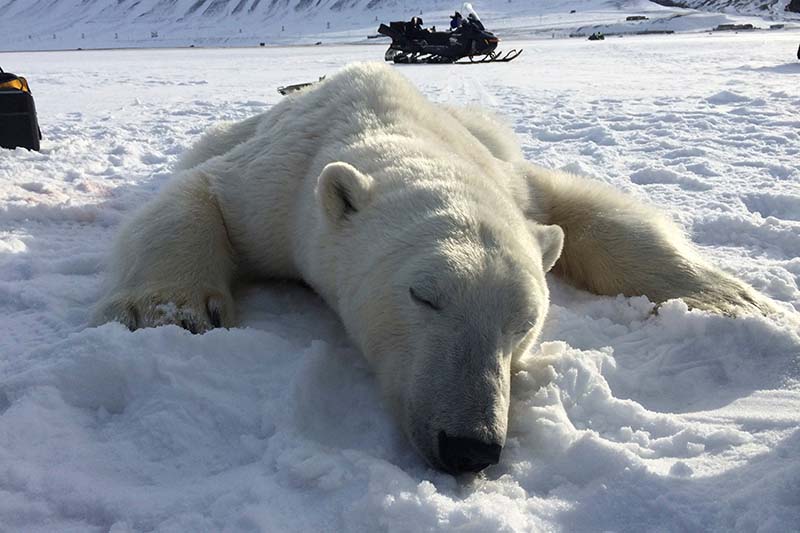As Norway's Arctic draws visitors, more polar bears get shot
ON BOARD THE POLARSYSSEL: More polar bears are being shot dead on Norway's remote Arctic islands, where dangerous encounters with humans are getting more frequent as visitors increase and global warming melts the sea ice on which the creatures roam.
Halfway between the northern tip of Europe and the North Pole, the Svalbard archipelago of snow-capped mountains and glaciers is home to 2,654 people and 975 polar bears, according to a 2015 tally by the Norwegian Polar Institute.
"Four polar bears have been shot so far this year," Vidar Arnesen, a chief police inspector for the governor of Svalbard, told Reuters. "In a normal year, one or two would be shot."
"There are more contacts between humans and the animals," he said aboard the Polarsyssel, the governor's ship, used for inspections and rescue operations.
Polar bears are a protected species and shooting them is allowed only for self-defence and as a last resort. Outside Svalbard's main settlements, people are obliged by law to carry the means to scare the animals away or defend themselves, with authorities recommending they take a gun.
A chain of incidents this year has highlighted the dangers.
In April, police stunned a three-year-old male sighted in the main town on Spitsbergen island, Longyearbyen, and flew him out by helicopter to a more isolated spot. The same month, a group of four Finnish tourists shot a polar bear in self-defence.
They were not fined, as police said they followed proper procedure - to group together and make noise to try and frighten away the animal from at least 200 metres, and only to fire if there is a risk of death or injury to humans.
POLICE INVESTIGATION
In June, a trapper preparing for the winter trapping season was fined 20,000 crowns ($2,468) when he shot a female polar bear in violation of the rules.
He mistakenly loaded his rifle with live ammunition instead of rubber bullets when trying to scare her away. Her cub was later euthanised as it would have not survived alone.
Police are currently investigating an incident last month in which a two-year-old female was shot dead near a camp of Russian scientists on a research trip.
Marco Lambertini, director-general of World Wildlife Fund International, told Reuters the shrinking area of sea ice available to the polar bears was contributing to the problem.
"The authorities on Svalbard should regularly review their guidelines to reduce the number of dangerous interactions between humans and polar bears," he said.
At the same time, Svalbard is experiencing a tourism boom: visitor nights on the archipelago hit 18,000 in the month of July, up 14 percent year-on-year.
The University Centre in Svalbard now hosts around 800 students a year, a doubling in five years, which increases the number of research expeditions.
"The possibilities of a hungry bear encountering a human being are increasing," said Lambertini.
TAKING PRECAUTIONS
Around the Arctic, there are an estimated 26,000 polar bears, according to a "Red List" of threatened species by the International Union for Conservation of Nature, which also highlights the threat to the species from retreating sea ice.
Polar bears rarely kill people: the most recent victim was a British teenager who died while camping on the ice in 2011. In 2015, a Czech tourist visiting for a solar eclipse suffered slight injuries when a polar bear ripped open his tent. The animal was shot dead.
For locals, living with polar bears involves routine precautions. At the Ny-Aalesund research station, the northernmost civilian settlement in the world at 79 degrees north, the 70-odd scientists and support staff leave the front door of every house unlocked so that people can seek refuge if needed.
"Once I was on a rubber boat and about 20-25 metres away, on the beach, there was a polar bear. We drove the animal away by revving the engines," said Max Schwanitz, 54, a German who supervises scientific research diving.
Residents at Ny-Aalesund have sighted six or seven polar bears this summer, the last time some six weeks ago. The animal swam out of the sea and walked within a few dozen metres of the settlement before disappearing.
"The first time I saw one, it was in the middle of town. I was amazed at how huge it was," said Aasne Dolve Meyer, 41, who works for a company supporting the research institutes. "After that I always made sure I checked my surroundings before leaving the house."
($1 = 8.1025 Norwegian crowns)






